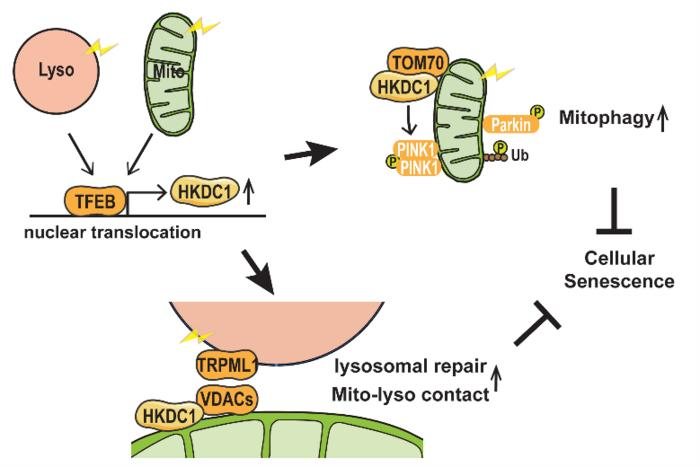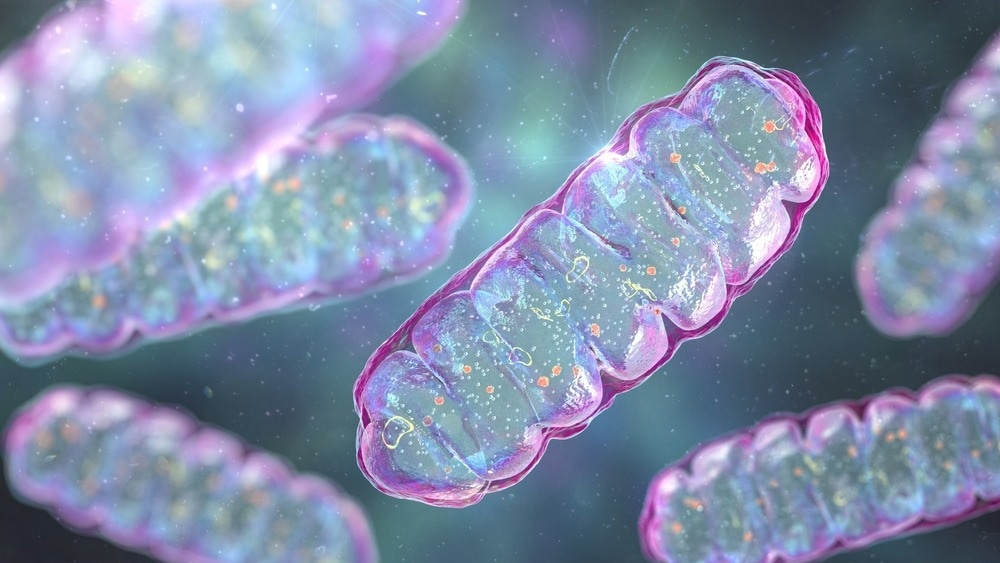Reviewed by Danielle Ellis, B.Sc.Jan 2 2024
Healthy organelles are essential to the operation of the cell, just as healthy organs are essential to human well-being. Certain subcellular structures perform unique functions inside the cell; for example, lysosomes maintain the cell's cleanliness, while mitochondria provide energy to the cell.
 Both mitochondrial and lysosomal stress stimulate TFEB nuclear translocation, followed by increased HKDC1 expression. HKDC1 stabilizes PINK1 through interaction with TOM70, thereby facilitating PINK1/Parkin-dependent mitophagy. Additionally, HKDC1 and the VDAC proteins with which it interacts are important for repair of damaged lysosomes and maintaining mitochondria–lysosome contact. HKDC1 prevents DNA damage–induced cellular senescence by maintaining mitochondrial and lysosomal homeostasis. Image Credit: 2024 Cui, et al., HKDC1, a target of TFEB, is essential to maintain both mitochondrial and lysosomal homeostasis, preventing cellular senescence, PNAS.
Both mitochondrial and lysosomal stress stimulate TFEB nuclear translocation, followed by increased HKDC1 expression. HKDC1 stabilizes PINK1 through interaction with TOM70, thereby facilitating PINK1/Parkin-dependent mitophagy. Additionally, HKDC1 and the VDAC proteins with which it interacts are important for repair of damaged lysosomes and maintaining mitochondria–lysosome contact. HKDC1 prevents DNA damage–induced cellular senescence by maintaining mitochondrial and lysosomal homeostasis. Image Credit: 2024 Cui, et al., HKDC1, a target of TFEB, is essential to maintain both mitochondrial and lysosomal homeostasis, preventing cellular senescence, PNAS.
The management and maintenance of these two organelles remain poorly understood despite the fact that damage to them has been associated with aging, cellular senescence, and other illnesses. Osaka University researchers have now discovered HKDC1, a protein that is essential to the upkeep of these two organelles and, thus, helps to delay the aging process of cells.
Although the targets of a protein known as TFEB were unknown, there were indications that the protein was involved in preserving the function of both organelles. Through the use of chromatin immunoprecipitation, a technique that allows the identification of protein targets on DNA, the team compared all the cell's active genes under specific conditions.
This allowed them to be the first to demonstrate that TFEB directly targets the HKDC1 gene and that HKDC1 is upregulated in response to mitotic or lysosomal stress.

Image Credit: Kateryna Kon/Shutterstock.com
The methodical elimination of damaged mitochondria, or "mitophagy," is one way that mitochondria are shielded from harm. There are several different mitophagy routes, and the most well-studied one relies on the Parkin and PINK1 proteins.
We observed that HKDC1 co-localizes with a protein called TOM20, which is located in the outer membrane of the mitochondria, and through our experiments, we found that HKDC1, and its interaction with TOM20, are critical for PINK1/Parkin-dependent mitophagy.”
Mengying Cui, Study Lead Author, Osaka University
To put it simply, TFEB brings in HKDC1 to assist in clearing up the mitochondrial waste. What about lysosomes, though? In this case, TFEB and KHDC1 are also important participants. It has been demonstrated that reducing HKDC1 in the cell interferes with lysosomal repair, suggesting that TFEB and HKDC1 aid in lysosome damage recovery.
HKDC1 is localized to the mitochondria, right? Well, this turns out to also be critical for the process of lysosomal repair, you see, lysosomes and mitochondria contact each other via proteins called VDACs. Specifically, HKDC1 is responsible for interacting with the VDACs; this protein is essential for mitochondria–lysosome contact, and thus, lysosomal repair.”
Shuhei Nakamura, Study Senior Author, Osaka University
By simultaneously preserving the integrity of these two organelles, the two distinct functions of HKDC1, which play important roles in the lysosome and the mitochondria, contribute to the prevention of cellular senescence. This finding provides new opportunities for the treatment of age-related disorders since malfunction of these organelles is associated with aging.
Source:
Journal reference: